
by | Oct 2, 2014 | Building Muscle, TDEE/BMR, Troubleshooting
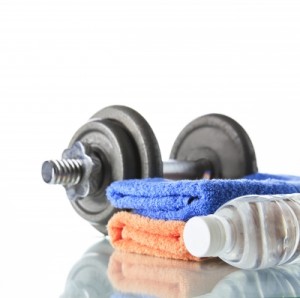 Experienced lifters know the importance of rest between sets, which can be anywhere from 30-90 seconds, depending on how quickly you recover. They also know that rest days from weight lifting — even during the week — are important, and structure their sessions so they can train one body part while the others are getting a rest. But, did you know that it is even more important to take an entire week off from strength training?
Experienced lifters know the importance of rest between sets, which can be anywhere from 30-90 seconds, depending on how quickly you recover. They also know that rest days from weight lifting — even during the week — are important, and structure their sessions so they can train one body part while the others are getting a rest. But, did you know that it is even more important to take an entire week off from strength training?
Some refer to rest weeks as de-load or recovery weeks. Whatever you prefer to call them, they are necessary. This is an opportunity to give your entire body rest from lifting heavy weights, and even from high intensity cardiovascular workouts that put a strain on the body and the mind.
Rest weeks are unfortunately over looked by many weightlifters — especially newbies — because they think the few days during the week that they rest (if they rest) is enough. They have the “no pain, no gain” mentality. They feel that the more they do, the better and stronger they will get and the quicker they will reach their goal. Actually, failing to take longer breaks will affect your progress in a negative way.
This magic of building muscle does not happen while you are actually lifting the weights. Instead, it happens while you rest. Surprised? Yes, I was too! When you lift weights to build muscle, you are tearing the small muscle fibers. Quick science lesson…After you workout, your body begins to repair damaged muscle fibers through a cellular process where it pulls the fibers together to form new muscle protein strands, or myofibrils. These repaired myofibrils increase in thickness and number to create muscle growth. Muscle growth occurs whenever the rate of muscle protein synthesis is greater than the rate of muscle protein breakdown. All of this happens while you are not working out! This machine — called the body — is truly amazing!!

I know a whole week away from the iron may put some into withdrawal! But you can make it an active rest week where you’re engaged in your favorite sport or in low intensity cardio like walking, yoga, or your favorite aerobic DVD a couple of days during the week. But, no lifting or HIIT! And, don’t forget to continue to eat balanced meals of proteins, carbohydrates, and fats. It’s important to continue to feed those muscles while they are repairing. This simply means DO NOT restrict or lower your calories because you are not working out as much! In fact, it may be a good idea to eat at your TDEE along with making good food choices during this rest period. If you are cutting during your recovery, you may want to decrease your deficit from 10% to 5%. You want to make sure any losses that week are not muscle. Remember, the whole point of recovery week is for your muscles to have a chance to repair. So, don’t plan to run a marathon during this time!!
If you’ve been lifting weights and/or doing high intensity workouts and have not taken a rest week, you are well overdue for a much needed break. It’s a good idea to plan a rest week every 4 to 5 weeks to let that muscle rest, repair, and grow. Then the weeks following your rest, you will feel refreshed, energized and ready to take your performance to the next level.
Photo credit: stockimages, naypong
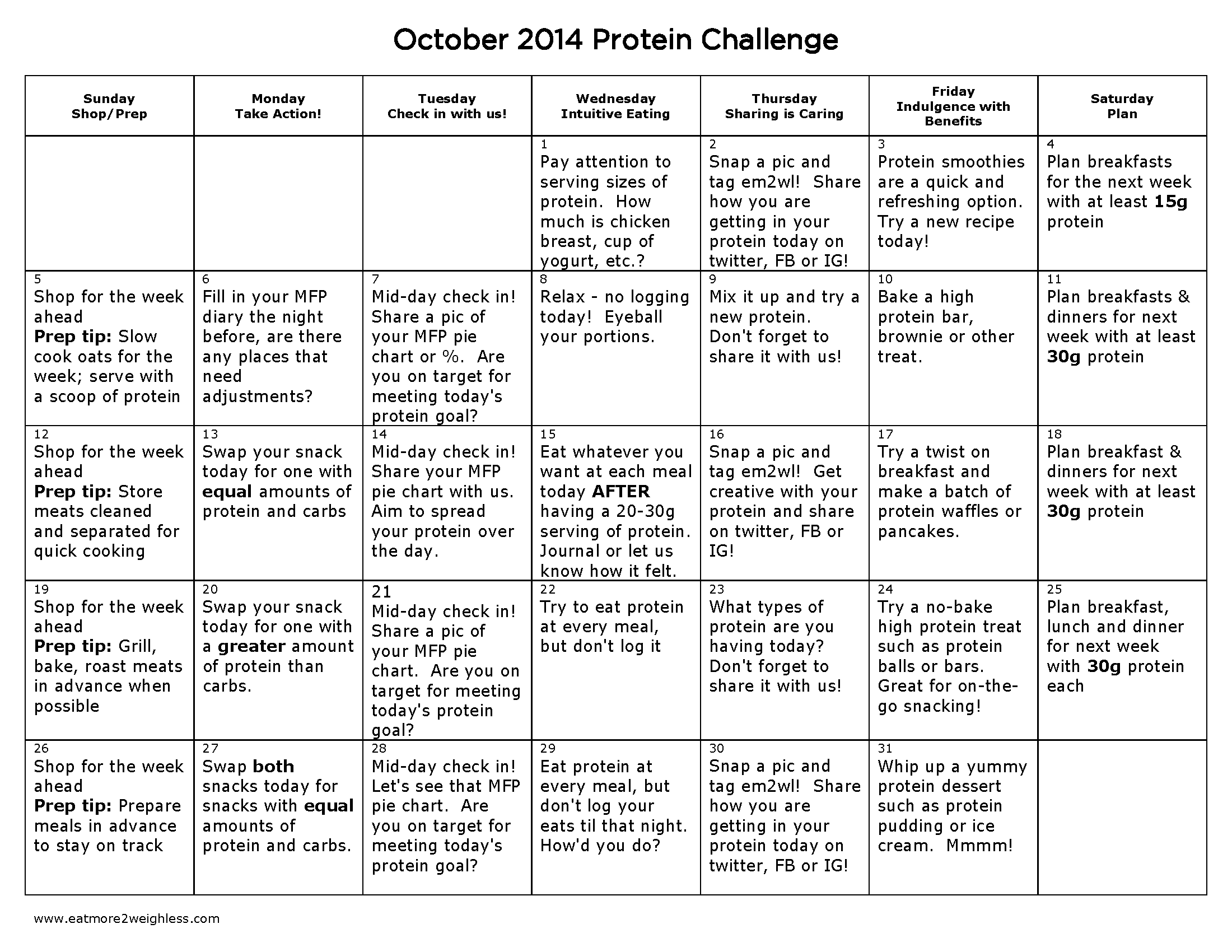
by Trish Adams | Sep 30, 2014 | Building Muscle, Life Application: Monthly Calendars
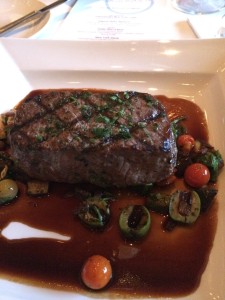 This month’s challenge focuses on meeting our protein goals. You’ve heard us harp on eating sufficient protein enough to know how we feel about it. When it comes to your fitness goals, whether that includes packing on muscle, increasing strength, power or endurance, shedding fat or maybe even a little bit of each, protein plays an important role.
This month’s challenge focuses on meeting our protein goals. You’ve heard us harp on eating sufficient protein enough to know how we feel about it. When it comes to your fitness goals, whether that includes packing on muscle, increasing strength, power or endurance, shedding fat or maybe even a little bit of each, protein plays an important role.
Including enough protein in your diet helps to maintain, build and repair muscle which is important for all goals. When you fall short your progress may also suffer. Of course all macronutrients play an important role, but it seems many struggle specifically with consuming enough protein. So, with that said, here’s what you can expect with this month’s challenge:
Plan
On your planning days you will decide what your protein sources will be for the upcoming week. Don’t worry – you won’t start off planning every meal in your day. We’ll take it slow, starting with breakfast and work our way up from there. The great thing about planning out the week is that you’ll reduce the stress of trying to figure it out as you go. Once you’ve established the habit of consuming protein with each meal, you will be able to wing it a bit more. Until then, we plan!

Shop & Prep
Once you have your protein sources identified, it’s time to hit the store and get stocked up. When possible make things easy by prepping your protein by either cleaning/seasoning it ahead of time or even cooking it and storing in the fridge.
Take Action
This is when the rubber meets the road by putting your plan into action! You’ll be swapping out low protein snacks with ones that offer higher protein, progressively increasing the amount as the month goes by. Set yourself up for success by completing your MFP diary the night before.
Check in with us
This is a fun one! You’ll look over your MFP chart (or Lose It! or whatever meal tracking app you use) midday to see how you’re doing, and then share it with us on one of our social media sites.* Are you on track to meet your overall protein goal for that day? Are you spreading your protein throughout the day? Very often we will leave the bulk of our protein for the end of the day. No bueno! Protein is easier for most ladies to fit in, and better absorbed by the muscles in smaller amounts of 20-30g.
Intuitive Eating
On this day you’ll relax things a bit and see how you manage without tracking. Keep calm! Take note of different serving sizes of proteins so that, in the future, you can eyeball portions. At the end of intuitive eating days evaluate how you fared. Treat these days as a learning experience, not a pass or fail!
 Sharing is Caring
Sharing is Caring
Once again you’ll check in on one of our social sites,* but this time we want to see pics of your food! We want you to move beyond chicken (although chicken is fine, too!) and be a little bit adventurous. Protein can be found in many foods other than the obvious meat, poultry and fish. Go outside your comfort zone and look to other sources such as seeds, nuts, beans and even vegetables. Let us see how you’re mixing things up, and making it work for YOUR lifestyle! The fam is all about paying it forward. Whether you’re struggling to get in the protein, or you’ve made crazy strides with your protein goals, share with the fam. You might even inspire someone or get inspired. #em2wlproteinchallenge
Indulgence with Benefits
On this day you’ll explore treats that also offer a good serving of protein. Ice cream, muffins, brownies are all on the menu! Although they offer protein they are treats so you should still enjoy them in moderation.
Remember, protein is your friend regardless of your fitness goals. It helps you to maintain or increase your muscle mass as well as provide other benefits like increased satiety and slowing the digestion of carbohydrates which helps stabilize blood sugar levels. As a general guide we recommend that 30% of your diet be from a protein source. If you’re new to all of this you may want to start with just hitting 100g/day and increasing from there. You can also evaluate your body type to help you choose a starting point.
As you can imagine trying to choke down 100g or more of protein over a couple of meals would be very hard. So aim to eat some protein with each of your meals. You will make hitting your protein goal much more attainable and will improve the absorption by your muscles. Enjoy the challenge!
*Social Sites for Sharing the challenge: (Facebook, Twitter, Instagram, Pinterest, or the Forum. Be sure to tag us on your chosen network, and hashtag #em2wlproteinchallenge so that others can get ideas!

Click to enlarge

by EM2WL | Sep 24, 2014 | Building Muscle, Fat Loss / Cutting, Motivation
 You may have noticed, since beginning weight lifting, and feeding your body properly, that some clothes still fit your new shape while others fit, well…differently. You look great in yoga pants, yet you can’t seem to get your jeans over your butt. You look great naked, but when you put on those shorts your thighs look like… “quadzilla??” Perhaps you weigh the same as you did before, or maybe you’ve gained a few extra pounds. A quick measurement check reveals that though you have lost inches in some areas, you’ve actually gained inches in others.
You may have noticed, since beginning weight lifting, and feeding your body properly, that some clothes still fit your new shape while others fit, well…differently. You look great in yoga pants, yet you can’t seem to get your jeans over your butt. You look great naked, but when you put on those shorts your thighs look like… “quadzilla??” Perhaps you weigh the same as you did before, or maybe you’ve gained a few extra pounds. A quick measurement check reveals that though you have lost inches in some areas, you’ve actually gained inches in others.
Is this supposed to be happening?
The answer is: Yes. It is because your body composition has changed, in a good way! Body composition is the proportion of fat, muscle and bone that make up the body. It is measured by the percentage of body fat and the percentage of lean body mass that you have. Resistance training along with an appropriate calorie intake, and proper macronutrients is the foundation of these amazing changes.
When I decided to make fat loss my ultimate goal — by adding resistance training to my workouts — I assumed that meant I would automatically fit into a smaller size. I slowly saw the changes to my body in the mirror and I loved what I was beginning to see. I embraced the slimming in some areas and the new curves in others. But when I went shopping for new pants, I would get discouraged. The sizes and styles that I tried on, thinking they should fit…didn’t. The smaller sizes were a little too tight in the hips, the larger sizes were too big in the waist! When I tried on shirts, some were tight around the biceps while others were tight across the back and chest.
But I didn’t give up.
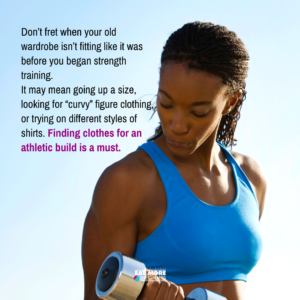 As I continued to try on different styles, sizes, and designers, I finally found a rack of designer pants that made classic, straight, and curvy fit. Yay! I chose one of each cut, in 2 different sizes. The curvy pant was made just for me. I turned from side to side admiring how awesome I looked and felt. But soon reality hit…
As I continued to try on different styles, sizes, and designers, I finally found a rack of designer pants that made classic, straight, and curvy fit. Yay! I chose one of each cut, in 2 different sizes. The curvy pant was made just for me. I turned from side to side admiring how awesome I looked and felt. But soon reality hit…
It was one size larger than what I thought I should be in. I found myself depressed over a number some guy put on a label inside a pair of pants. Shame on me!! I loved the way I looked and felt. I decided that it was time for me to ditch the number on the label in my pants like I did the scale!
So don’t fret when your old wardrobe isn’t fitting like it was before you began strength training. Look for a designer that makes clothes for your female figure. We really need to stop buying clothes made by designers who think women are shaped like 12-year-old boys. It may mean going up a size, looking for “curvy” figure clothing like I did, or trying on different styles of shirts, but finding clothes for an athletic build is a must.
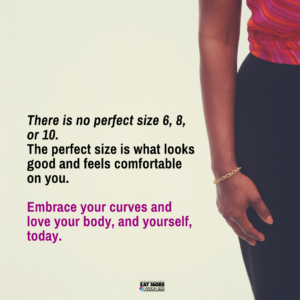 If you have been in the department stores lately you will also see beautiful long skirts and palazzo pants in gorgeous fall solid colors and prints that are perfect for figures between sizes. Many of these have elastic waistbands that will fit as you continue to lose fat, so you won’t have to buy smaller sizes! It’s important to choose clothing that not only looks fashionable, but also feels comfortable!
If you have been in the department stores lately you will also see beautiful long skirts and palazzo pants in gorgeous fall solid colors and prints that are perfect for figures between sizes. Many of these have elastic waistbands that will fit as you continue to lose fat, so you won’t have to buy smaller sizes! It’s important to choose clothing that not only looks fashionable, but also feels comfortable!
Remember, there is no perfect size 6, 8, or 10. The perfect size is what looks good and feels comfortable on you.
Embrace your new curves and love your body, and yourself, today.

by EM2WL | Sep 11, 2014 | Building Muscle, Consistency, Fat Loss / Cutting

If you’re newer to lifting, or perhaps just newer to lifting heavy – at some point you’ll wanna know just how long to see results from lifting.
Back in the day, it was easier to avoid the message that “lifting heavy changes your body, ” but lately it seems that most fit pros and enthusiasts have finally hopped on board. Whether you’ve decided to test the waters with Crossfit, finally hired a trainer, or simply do some workouts that you find on the internet: you’re lifting heavy, you’re loving it…and you’re not seeing these “miraculous” changes that everyone seems to be promoting. What.is.the.deal?
Here’s eight reasons why you may not be seeing results yet:
You still aren’t lifting heavy enough
I’m sure this is insulting to most people reading this. I mean, of course you’re lifting heavy enough. It’s a heavy weight, and you feel the burn when you lift it. Every body part requires a different weight. So if you’re using only one or two weight sizes, for your entire body – then it’s not possibly heavy enough for every area. A dumbbell of 10-12 pounds may be excruciatingly heavy for your smaller muscle groups like rear delts, but most ladies can lift much more than that for a back, chest, or leg movement. If you’re able to go beyond 12 reps on most exercises, it’s probably time to increase your weight.
Don’t think that you hard-core-iron-heads are exempt from this one. Sometimes, vets, we can be just as likely to get comfy with a certain weight. Are you’re cranking out 25lb dumbbell rows, just because it seems heavy enough for your 10-12 rep range? Or because it’s the highest weight available? Could you possibly go up to 30 or 35? Who cares if you can only make it to six to eight reps before you fail? Accept the challenge — if you can do it with good form — and work your way back up to 10 reps. If you can’t make such a huge jump, add some weighted gloves and increase by only two to four pounds at a time rather than the entire five. Either way, find your max for that number of reps, and then push past it. The only way to continue to see changes is to continually challenge yourself.
You’re basing your “results” judgement on a scale number
We’ll often hear from ladies who are lifting and aiming for fat loss say things like “I must be doing something wrong…I should have lost ‘X’ pounds/dress sizes by now”
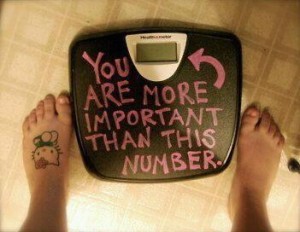 Ummm…Says who??? ;) How do we determine how many sizes we should be up or down within a year? I pray not by the same industry standards that tell us to “eat-less-than-you-need-to-support-your-body-in-a-comatose-state” for weight loss?
Ummm…Says who??? ;) How do we determine how many sizes we should be up or down within a year? I pray not by the same industry standards that tell us to “eat-less-than-you-need-to-support-your-body-in-a-comatose-state” for weight loss?
Sure…there will always be tweaks that you’ll want to make, but if your butt looks freakin amazing – take a moment to accept that, rather than be overly concerned about the number on the scale OR inside of your jeans.
Too many of us are still being held captive by our scale weight…or some other tracking method that doesn’t take into account the type of changes that are happening. Case in point: my pant size can vary from a size two to TEN in about 60 seconds (yet look just as lean in either size). How is this possible? My butt has seriously gotten so high that it ranges from one extreme to the other, based on the rise (and brand) of the jeans. If your body shape is changing, maybe it’s time to switch brand manufacturers. It sucks, but sometimes must be done. Trust me, you will see how great you look in clothes that fit. Every fashion book/expert on the market (that’s worth a darn) will tell you to stop giving two hoots about sizes. This is because no matter how small you are, sizes will vary — per person — in fit. FIT is everything.
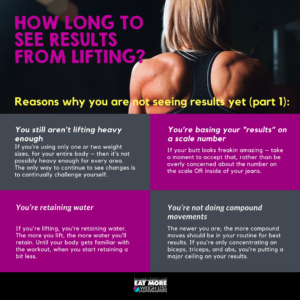 Confession time: The other day, I went out in frustration over all my older, lower rise jeans that weren’t fitting. Taking my own redundant advice — I bit the bullet and bought the exact same jeans in LARGER sizes to make sure they fit over my butt. Listen…the size was WAY larger…would you know I had FIVE people tell me I need to STOP losing weight when I was wearing those jeans?! I have gained over 10 lbs (apparently all in the bootay)!! But wearing jeans that FIT ME (note…did not say jeans that “I fit” into to) FIT, baby. Get clothes that fit, forget the rest. By the time you can squeeze into jeans from over a year ago, they’re probably outdated anyway :P
Confession time: The other day, I went out in frustration over all my older, lower rise jeans that weren’t fitting. Taking my own redundant advice — I bit the bullet and bought the exact same jeans in LARGER sizes to make sure they fit over my butt. Listen…the size was WAY larger…would you know I had FIVE people tell me I need to STOP losing weight when I was wearing those jeans?! I have gained over 10 lbs (apparently all in the bootay)!! But wearing jeans that FIT ME (note…did not say jeans that “I fit” into to) FIT, baby. Get clothes that fit, forget the rest. By the time you can squeeze into jeans from over a year ago, they’re probably outdated anyway :P
You’re retaining water
Yeah, yeah…we’re all tired of this excuse. But let’s face it. If you’re lifting, you’re retaining water. Sometimes LOTS of water. The more you lift, the more water you’ll retain. If you’re doing tons of HIIT, then consider it the cherry on top of your water-retention-sundae. Until your body gets familiar with the workout, when you start retaining a bit less. But then you change it again. And retain more water. It’s an ugly cycle. But not really. It is what it is. Ladies, we really have to get over this whole “water weight” thing. The more muscle mass you build, the more water you’ll begin to retain at all times. This really isn’t such a bad thing, but rather a sign that things are going well…as you’ll see here. But this does mean that you’ll have to give those scale dreams a rest, and focus on all the goodness and shifting that’s happening with your body. When it comes to lifting, things will occasionally appear to get worse before they get better. I just consider it the “labor pains” of muscle delivery — a tad “painful” when it’s happening, but most of us wouldn’t trade that muscle baby for the world once it arrives. ;)
Side note: If you’re totally convinced/upset/depressed that your pants are getting tighter, perhaps you need to cut down on low rep squatting for a while? Work your lower rep squatting in in phases, so that you still get the muscle building benefits, but aren’t constantly retaining water. But, if you adore your 5×5 deadlifts or what have you, just accept that you may be retaining some serious water…and invest in jeggings.
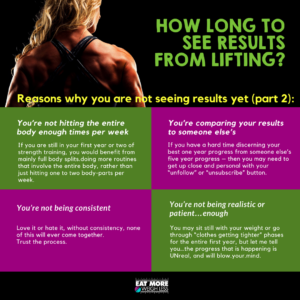 You’re not doing compound movements
You’re not doing compound movements
If you’re not seeing major body changes, it could be for lack of major body movements. If you’re hitting the gym and only concentrating on biceps, triceps, and abs, you’re putting a major ceiling on your results. Compound movements are the basis of most effective routines for a reason. They work in the actual way that your body works, strengthening your joints and tendons (in addition to your muscles), working multiple muscle groups at once, and burning more calories overall than an isolated move hitting the same muscle group would. Obviously, there’s a time and place for everything, including isolated moves, but generally the newer you are, the more compound moves should be in your routine for best results.
You’re not hitting the entire body enough times per week
As with compound moves, newbies should be doing more routines that involve the entire body, rather than just hitting one to two body-parts per week. The traditional splits that are seen in the bodybuilding community work extremely effectively…for veteran bodybuilders. If you are still in your first year or two of strength training, you would benefit from mainly full body splits. Not only do these types of workouts get the heart rate up higher, they also produce faster results. Generally speaking, the less amount of time you’ve been lifting, the more often you can work that body-part per week. A typical newbie routine could consist of up to 3 total body workouts per week, or 2 upper, 2 lower (alternating). The opposite often holds true for vet lifters who need more rest per part — hitting the body part hard, with higher volume, 1-2xs/week, max is optimal and prevent over-training.
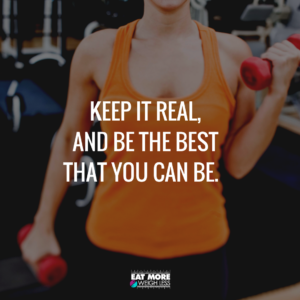 You’re comparing your results to someone else’s
You’re comparing your results to someone else’s
Try not to compare yourself to anyone else. If you feel the need to look around for an ideal body goal to shoot for, make sure that it aligns with YOUR genetics, time, interest, and drive. Most importantly, note their starting point. There’s no point in shooting to look like a pro figure competitor, when you don’t have the inclination or desire to put in the time that they do. There’s also no use comparing yourself to someone who has taken over a decade to attain their body, and bashing yourself for not accomplishing similar results in your first year of lifting. Hint: most women you see in fitness magazines, Instagram, or the internet — with any amount of muscle “tone” — have put in years of serious training and eating (and/or have been photoshopped…but I digress). Keep it real, and be the best that you can be. If you have a hard time discerning your best one year progress from someone else’s five year progress – then you may need to get up close and personal with your “unfollow” or “unsubscribe” button. Don’t keep images, magazines, or Facebook “friends” around that make you feel that you’re accomplishing nothing. Surround yourself with pictures of yourself, and compare new pictures of yourself to the ones from the beginning of this journey. (But please don’t compare pics of your 40 year old self to pics of your 15 year old self…that’s just plain freaky)
You’re not being consistent
Love it or hate it, without consistency, none of this will ever come together. If someone lifts, gets frustrated because the results aren’t coming fast enough, and then goes back to cardio madness, they will be convinced that nothing is working. Repeatedly lowering cals in a muscle building phase, or under-cutting rest periods in a strength phase, or only sticking to a workout for a couple of weeks before switching “back” is a recipe for disaster. Trust the process. As mentioned previously, most lifters with ultra defined musculature took years, upon years, upon Y.E.A.R.S. to develop. Getting frustrated because you don’t look like a person on a magazine/DVD cover, your personal trainer, or (fill-in-the-blank) WFBB Pro, after completing a 4-12 week program will not make the process go any faster. In fact, it makes take wayyyy longer. Think of your journey as a college degree, every time you “change your major” you tack on time to your journey. If you plan on seeing some impressive results, you’ve gotta buckle down, make the decision, and stick.with.it. Constantly doubting, and thinking that things aren’t working — creates the exact environment you’re expecting.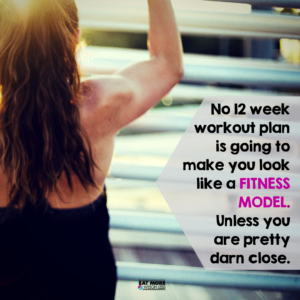
You’re not being realistic or patient…enough
It’s really hard to put your lifting progress on a timetable. Especially in the first year or so of lifting when you’re getting the most coveted results of any lifter: newbie gains. losing fat and gaining muscle at the same time. It will never again happen in your lifetime of lifting, but it can’t be measured by typical dieting methods of measurement. You may sit still with your weight or go through “clothes getting tighter” phases for the entire first year, but let me tell you…the progress that is happening is UNreal, and will blow.your.mind. It’s just sad that so many of us come from a dieting standpoint and expect things to be so perfectly linear, that we never see results of all the hard work we put in come to fruition. We get scared, run back to “old” methods, and then when those methods “appear” to be working – we assume that it’s because we went back to the old stuff (cardio/circuits/super restrictive eating/starving), not actually understanding that it’s results of lifting that were there all along. So then we keep doing the old stuff, thinking that it will only get better, only eventually undo the results, and put ourselves back at square one.
Vets: how long did/has it taken you to see results? Any tips for a newbie or frustrated lifter that’s just not seeing the results they want?

by EM2WL | Jun 30, 2014 | Building Muscle, Self Acceptance, The Journey
Perpetual diets often land us on a completely different path than expected. Many of us find ourselves on the frontline of Eating Disorder recovery, or fighting off the ED thoughts that a lifetime of dieting encourages. April shares a reflection of her mental journey with ED, an amazing encouragement for those still in the struggle.
 It’s been about two years since I met Kiki and Lucia and the EM2WL society. Two years since I started really listening to the advice given to me. Two years since I started fighting the false need to restrict and purge, two years since I threw out the 100-calorie meals and traded them in for what my body really needed, two years since I put down the baby weights and picked up a barbell.
It’s been about two years since I met Kiki and Lucia and the EM2WL society. Two years since I started really listening to the advice given to me. Two years since I started fighting the false need to restrict and purge, two years since I threw out the 100-calorie meals and traded them in for what my body really needed, two years since I put down the baby weights and picked up a barbell.
It hasn’t been easy.
The summer of 2012 is when it all began, and I remember it so well. With the encouragement of EM2WL, I’d started to eat a bit more, quite a bit more, and lifting just prior to our summer vacation in Canada. I was still working out like a maniac, getting up at 5am for cardio and then following it up with weights after work. The idea of going to a foreign country without any specific workout schedule was debilitating. The weeks leading up to vacation, I had mini panic attacks that only slowed to a mild fear once my friend secured me a 3-day pass to the Y for our visit.
Also during those weeks, I started to bloat. The extra calories I was consuming (and needed) were throwing my poor body out of whack. My metabolism was such a mess from years of underfeeding it that my body had no choice but to bloat up. My children’s size 12 jean leggings were starting to get too tight, but I shoved myself into them during that vacation. I still fit into my double zero shorts, but barely, and I could see the bloat. I didn’t help matters by drinking a lot of wine that week and staying up late after everyone went to bed to binge on “healthy” snacks I’d brought with us. They were calories I needed, but I ate most of my calories all at once late at night along with a glass of wine. I was so tempted to purge, but I couldn’t since it wasn’t our house, and it was a small house. I would have been heard. I’d never felt so fat.
 Once we got home, we had a few weeks before our next vacation – a long weekend on Chincoteague Island. I spent the time detoxing and getting back into my workouts, and I started to feel a bit better. My body was still bloated, and I bought children’s size 14 jean leggings, but for the most part, I still thought I could fit into my double zeros forever. I was determined to do so. Somehow, despite the recent bloating, the four days on the Island were the last days I ever felt “skinny.”
Once we got home, we had a few weeks before our next vacation – a long weekend on Chincoteague Island. I spent the time detoxing and getting back into my workouts, and I started to feel a bit better. My body was still bloated, and I bought children’s size 14 jean leggings, but for the most part, I still thought I could fit into my double zeros forever. I was determined to do so. Somehow, despite the recent bloating, the four days on the Island were the last days I ever felt “skinny.”
Then we came home, and I started the New Rules of Lifting for Women. Now I REALLY gained weight. I still ate more and lifted heavy, and I was forced to face facts: I would have to buy new clothes.
Over the next year or so, I pretty much hated myself. I’d spend nights binging and sometimes purging. I stuffed my body into clothes that were too tight, praying for my weight to drop. I played with the idea of restricting again, and occasionally, I gave in. Sometimes I changed my mind about lifting and went back to cardio, but nothing changed. Throughout it all, Kiki and Lucia and a handful of others stuck around. They listened to my complaints and encouraged me to keep pushing forward. They filled my head with more and more knowledge about how to eat and what was happening to my body and why lifting is so important.
Eventually, I bought clothes that fit and started to feel marginally better. Gradually, I learned what kinds of workouts my body could handle without destroying my mental state. I finally stopped killing myself with 2 workouts/day and limited most of my cardio to HIIT (albeit LONG HIIT) and hid my scale away which made a HUGE difference in the way I felt about my body.
 I can’t pinpoint the exact date or even the exact month, but at some point during 2013, my metabolism evened out. The bloating disappeared. I was still heavier and larger than I’d been during most of my late 20s, but I started to have “sleek” days. I started to enjoy lifting and to rejoice over the NSVs.
I can’t pinpoint the exact date or even the exact month, but at some point during 2013, my metabolism evened out. The bloating disappeared. I was still heavier and larger than I’d been during most of my late 20s, but I started to have “sleek” days. I started to enjoy lifting and to rejoice over the NSVs.
I can confidently say that 2014 has been the best year of my life in all the ways that matter. I’m learning about lifting phases and how to plan my workout rotations to keep my body guessing. I no longer stress my body with long HIIT or steady state sessions which means more time with my family. I FINALLY allow my body 2 days of rest each week, and to my surprise, that small change filled me with such relief! It was as though I was finally giving myself permission to sit back and enjoy those weekends without the stress of choosing a workout and trying to burn calories. Most days, I feel great!
I still stress sometimes over calories numbers – calories burned during workouts and calories consumed. I still have my “yuck” days, and I am still TERRIFIED to take a full rest week during vacation this year!
But I’ve learned so much over these past two years and come so far, it’s hard to believe I’m the same person. I no longer look at the pictures of myself when I was 90 pounds and yearn to be that small anymore. I’ve thrown out all of my double zeros and don’t even care what the number on the tags are when I go shopping for new clothes. I have everything from small to large, from 4 to 9, and I just don’t care anymore so long as it fits well and looks good. I’m more confident than I’ve ever been. I’m talking my entire life. I still have the parts of me I’d like to make better, but for the most part, I’ve given up the comparison to other women and the self-name-calling. I’ve given up looking at myself every day and walking away “knowing” I am fat. Because I’m not. Because I’m strong and fit and healthy and beautiful. I don’t feel that every day, but I almost never hate myself.
I could never have gotten here without all of you. Never. Thank you all so much for your love and support, for encouraging me through this journey rather than giving up on me. Here’s to the journey, no matter how tough. The end is nowhere in sight, but possibilities are endless.

Strong and fit!

by EM2WL | Jun 5, 2014 | Building Muscle, Cardio, Fat Loss / Cutting, Nutrition
Q: I’ve been lifting for about a year. I love my time at the bar, but I’m frustrated by my lack of progress! I see my training partner’s lifts going up consistently, but I can’t seem to push past plateaus! What am I doing wrong?
A: There are a number of possible explanations why you may have hit a plateau with your lifts. Be aware that almost everyone reaches a point where their lifts have stalled, but usually, when your lifts have stalled it is a good sign to look at your programming and determine if a small tweak or two could help.
It’s also important to remember that those new to lifting will make very quick progress regardless of what program they are following. After a few years of lifting however, it’s important to pay closer attention to the details.
Below are a few of the reasons why your lifting may have stalled.
1. Trying to lose fat (cals/carbs too low)
After you get past the stage of newbie gains, it is very difficult to gain strength while in a caloric deficit. You will probably find that you are able to consistently increase strength, gain muscle and lose fat (albeit very slowly) eating closer to your maintenance level calories. This isn’t to say that it can’t be done, but you will probably want to pay very close attention to nutrient timing, making sure to take in plenty of carbohydrates pre- and post-workout.
When trying to lose fat, many tend to view carbs as “optional.” However, if you are desiring to increase strength, cutting out carbs is not the wisest idea. Carbohydrates are your body’s preferred source of energy for intense workouts. Furthermore, when carbohydrates are adequate in the diet, it spares protein from being used for energy, and protein can do its job-build and repair muscle tissue.
When starting a cut, it’s best to decrease carbohydrates and calories very slowly, keeping an eye on your training and the way that you feel and tweaking things accordingly. If you are consistently feeling very run down and missing lifts in the gym, you may want to consider increasing your carbohydrates and possibly cutting back on the amount of fat that you are taking in.
Generally, slow-acting carbohydrates(sweet potatoes, whole grains, and low-glycemic fruits) are best consumed about 30 minutes to an hour prior to your strength training session. This will provide enough time for digestion so that you don’t go into your workout feeling overstuffed. Fast-acting carbohydrates (white potatoes or rice, foods high in sugar, or high-glycemic fruits) are best taken in during the hour after training.
Following an intense strength training session, your cells are depleted of both glucose and glycogen. Cortisol levels are also elevated. Fast-acting carbohydrates cause an increase in insulin levels, which in turn can cause greater muscle growth, when timed appropriately. When consumed, simple carbohydrates can be stored as glycogen, which is the primary source of muscle “fuel” during intense training sessions.
Post workout, elevated insulin levels allow muscle to better utilize stored glycogen for recovery and growth. This also helps cortisol levels to return to normal levels following an intense training session.
Don’t fear carbs, but learn how to use them to complement your training!
2. Too much emphasis on endurance activities
Another common mistake that strength trainers, especially women, make is of doing too many reps, too much cardio, and too many exercises that fatigue the smaller muscle groups. If your primary goal is to gain strength, you will want to keep your reps low and your weights high (3-5 reps at 80-85%1RM) on compound movements. Always do your compound movements (squat, bench, deadlift, rows, and presses) first, and use assistance work as needed to bring up weak points and provide an environment for hypertrophy. Assistance work should still be kept in the range of 8-12 reps for 3-5 sets. If you are able to do more than 12 reps, it is probably a good idea to increase the weight.
Cardio is a question that tends to come up frequently. A lot of women are okay with incorporating some strength training into their workout rotation, but panic at the thought of cutting back on or eliminating cardio. However, if your primary goal is to increase strength, too many endurance activities (i.e., steady-state cardio) can detract from the strength gains you are wanting to see.
If you still want to include some cardiovascular training into your workout rotation, the best scenario would be to add in some short (4-12 minute) metabolic finishers at the end of your strength training sessions. A metabolic finisher is an intense exercise or circuit of exercises designed to increase your body’s fat-burning potential by increasing the “afterburn effect” by increasing the number of calories burned as you recover from your workout. It speeds recovery by returning blood flow to the muscles and improving all-0ver conditioning and athleticism.
Good options for metabolic finishers include heavy kettlebell swings, tire flips, various forms of weighted carries, barbell complexes, sprints, prowler/sled work, and body weight exercises.
3. It’s all in your head
Sometimes, we are our own worst enemy to making progress. If you’re going for a PR, there should be no question in your mind that you will finish the lift. If you approach PR attempts with a fear of failing or a less than confident approach, chances are you will hinder any forward progress.
When you are going for a PR attempt, you must be completely confident as you approach the bar. Training with good spotters that you trust is crucial as you train with very heavy weights, especially as you go for lifts that are near 100% 1RM. There is a time and place for training to failure, but generally speaking, you will always want to end your training session successfully.
If you have any doubt in your mind that you won’t finish a lift, save it for another day.
4. Under- recovery between sets/training sessions
Another common mistake is failing to recover adequately, either in between sets or in between training sessions. It’s critical that the length of your rest periods lines up with your goals. Since it requires about 3 minutes for phosphagen stores to be replenished, 3 minute rest periods are probably most optimal if you are training for pure strength.
Full recovery will allow you to generate the most muscular power for each set, making each set as effective as possible. If you are training for pure strength, slow down in between sets, sip water, and get mentally refocused before beginning your next set.
Make sure that you are taking adequate time between training sessions to recover as well. A good rule of thumb is to take about 48 hours recovery in between intense training sessions. However, you can train opposing body parts on consecutive days (upper body on Monday, lower body Tuesday, rest Wednesday, upper body Thursday, lower body Friday). Make sure that your rest days are truly restful.
In addition, you will want to make sure that you are taking in plenty of high quality food, sleeping well, and keeping stress levels as low as possible to maximize your recovery time!
5. Attempting too much, too soon
It’s important to make sure that the strength goals that you have outlined for yourself are reasonable. Attempting to increase too much weight too soon will most likely result in injury, frustration, and breakdown in form.
Choose a solid, periodized program and determine to stick with it and trust the process! Training with sub-maximal weights will get you stronger over time. On a similar note, testing training maxes too often is extremely taxing on your CNS and will make recovery in between training sessions much more difficult. Focus instead on setting rep PRs, and leave training maxes to once every 4 weeks, at most.
Generally speaking, a reasonable expectation would be to see lower body lifts increase by about 10-20 pounds and upper body lifts increase by about 5-10 pounds over a 8-12 week period of time, provided you are being consistent in your training and paying attention to your nutrition. It may not seem like much, but over time, you will be amazed at your progress if you can learn to be patient with small strength gains.
6. Same old, same old
Our bodies are very good at making adaptations to the stressors that we place upon it. In order to continue to make progress, it is important to switch things up every once in awhile.
If you’re stuck at a strength plateau and have been following the same program or rep scheme for over 12 weeks, it is probably a good idea to switch things up. If you’re used to training in the 8-12 rep range, you may switch to a 5 x 5 for awhile and work on increasing your weights. If you’ve been training with heavy weights and low reps for awhile, you may benefit from an increase in volume. Varying your assistance work is an other great way to keep your body challenged!
However, a word of caution: make sure to change one or two things at a time and stick it out for a minimum of 8-12 weeks before changing another factor. It’s very important to make small changes and make careful notes about what is working. If you change too many things at once, you will never know what’s working!
7. Bad technique
Take the time to learn proper form, especially on the three big lifts (bench, squat, and deadlift). Always train to a full range of motion, and you will get the maximum benefit from each rep and set. If you are unsure about proper form on these lifts, you might benefit greatly from setting up an appointment to meet with a personal trainer, or watching instructional videos on Youtube. Start with the empty bar and be patient with yourself. Once you learn proper technique, it will become easier and easier to add weight to that bar and see the strength gains you desire!

 Experienced lifters know the importance of rest between sets, which can be anywhere from 30-90 seconds, depending on how quickly you recover. They also know that rest days from weight lifting — even during the week — are important, and structure their sessions so they can train one body part while the others are getting a rest. But, did you know that it is even more important to take an entire week off from strength training?
Experienced lifters know the importance of rest between sets, which can be anywhere from 30-90 seconds, depending on how quickly you recover. They also know that rest days from weight lifting — even during the week — are important, and structure their sessions so they can train one body part while the others are getting a rest. But, did you know that it is even more important to take an entire week off from strength training?







 You may have noticed, since beginning weight lifting, and feeding your body properly, that some clothes still fit your new shape while others fit, well…differently. You look great in yoga pants, yet you can’t seem to get your jeans over your butt. You look great naked, but when you put on those shorts your thighs look like… “quadzilla??” Perhaps you weigh the same as you did before, or maybe you’ve gained a few extra pounds. A quick measurement check reveals that though you have lost inches in some areas, you’ve actually gained inches in others.
You may have noticed, since beginning weight lifting, and feeding your body properly, that some clothes still fit your new shape while others fit, well…differently. You look great in yoga pants, yet you can’t seem to get your jeans over your butt. You look great naked, but when you put on those shorts your thighs look like… “quadzilla??” Perhaps you weigh the same as you did before, or maybe you’ve gained a few extra pounds. A quick measurement check reveals that though you have lost inches in some areas, you’ve actually gained inches in others. As I continued to try on different styles, sizes, and designers, I finally found a rack of designer pants that made classic, straight, and curvy fit. Yay! I chose one of each cut, in 2 different sizes. The curvy pant was made just for me. I turned from side to side admiring how awesome I looked and felt. But soon reality hit…
As I continued to try on different styles, sizes, and designers, I finally found a rack of designer pants that made classic, straight, and curvy fit. Yay! I chose one of each cut, in 2 different sizes. The curvy pant was made just for me. I turned from side to side admiring how awesome I looked and felt. But soon reality hit… If you have been in the department stores lately you will also see beautiful long skirts and palazzo pants in gorgeous fall solid colors and prints that are perfect for figures between sizes. Many of these have elastic waistbands that will fit as you continue to lose fat, so you won’t have to buy smaller sizes! It’s important to choose clothing that not only looks fashionable, but also feels comfortable!
If you have been in the department stores lately you will also see beautiful long skirts and palazzo pants in gorgeous fall solid colors and prints that are perfect for figures between sizes. Many of these have elastic waistbands that will fit as you continue to lose fat, so you won’t have to buy smaller sizes! It’s important to choose clothing that not only looks fashionable, but also feels comfortable!

 Ummm…Says who??? ;) How do we determine how many sizes we should be up or down within a year? I pray not by the same industry standards that tell us to “eat-less-than-you-need-to-support-your-body-in-a-comatose-state” for weight loss?
Ummm…Says who??? ;) How do we determine how many sizes we should be up or down within a year? I pray not by the same industry standards that tell us to “eat-less-than-you-need-to-support-your-body-in-a-comatose-state” for weight loss? Confession time: The other day, I went out in frustration over all my older, lower rise jeans that weren’t fitting. Taking my own redundant advice — I bit the bullet and bought the exact same jeans in LARGER sizes to make sure they fit over my butt. Listen…the size was WAY larger…would you know I had FIVE people tell me I need to STOP losing weight when I was wearing those jeans?! I have gained over 10 lbs (apparently all in the bootay)!! But wearing jeans that FIT ME (note…did not say jeans that “I fit” into to) FIT, baby. Get clothes that fit, forget the rest. By the time you can squeeze into jeans from over a year ago, they’re probably outdated anyway :P
Confession time: The other day, I went out in frustration over all my older, lower rise jeans that weren’t fitting. Taking my own redundant advice — I bit the bullet and bought the exact same jeans in LARGER sizes to make sure they fit over my butt. Listen…the size was WAY larger…would you know I had FIVE people tell me I need to STOP losing weight when I was wearing those jeans?! I have gained over 10 lbs (apparently all in the bootay)!! But wearing jeans that FIT ME (note…did not say jeans that “I fit” into to) FIT, baby. Get clothes that fit, forget the rest. By the time you can squeeze into jeans from over a year ago, they’re probably outdated anyway :P You’re not doing compound movements
You’re not doing compound movements You’re comparing your results to someone else’s
You’re comparing your results to someone else’s






Recent Comments